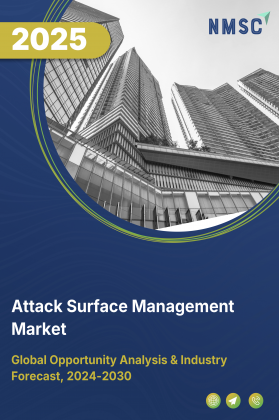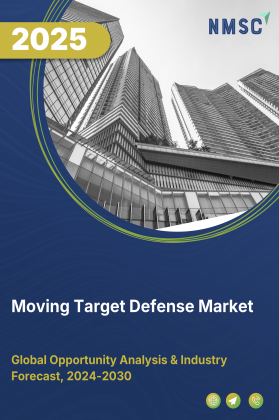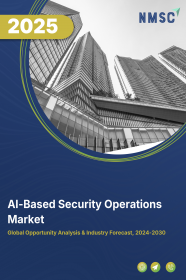
Attack Surface Management Market by Offering (Solutions, Services), by Deployment Model (Cloud, On-Premises, Hybrid), by Enterprise Type (SMEs, Large Enterprises), by Application (Visibility & Asset Inventory, Regulatory & Compliance Assurance, Proactive Risk Reduction, Digital Transformation Support), and by End User (IT & Telecom, BFSI, Retail & E-commerce, Healthcare, Manufacturing, Government, Aerospace & Defense, Others) – Global Opportunity Analysis and Industry Forecast, 2025–2030
Industry Outlook
The global Attack Surface Management Market size was valued at USD 1.32 billion in 2024, with an estimation of USD 1.74 billion in 2025 and is predicted to reach USD 6.87 billion by 2030 with a CAGR of 31.6% from 2025-2030.
The market is witnessing strong growth driven by the rising sophistication of cyber threats, the rapid expansion of IT infrastructure, and the increasing shift toward proactive security approaches. Organizations adopting cloud services, IoT, SaaS applications, and hybrid work models face expanding digital footprints that create more vulnerabilities, demanding continuous monitoring and protection.
ASM solutions address these challenges by providing real-time visibility, discovery, and risk prioritization of both known and unknown assets. However, high implementation and operational costs, particularly for SMEs, remain a restraint to wider adoption. At the same time, the growing wave of digital transformation and cloud adoption presents significant opportunities for ASM providers to expand their market reach.
Growing Cybersecurity Threats Drives the Market Growth
The rising sophistication of cyberattacks, including ransomware, phishing, and zero-day exploits, is a major factor driving the attack surface management market demand. With the adoption of cloud services, IoT, remote work, and third-party integrations, organizational attack surfaces are expanding rapidly, creating more vulnerabilities for malicious actors to exploit.
According to the World Economic Forum, 72% of businesses in 2025 believe cybersecurity risks are increasing, which underscores the urgent need for proactive security measures. Traditional tools fail to provide complete visibility over digital assets, whereas ASM solutions continuously discover, monitor, and secure both known and unknown assets, enabling businesses to mitigate risks and safeguard critical systems effectively.
Rapid Expansion of IT Infrastructure Boosts the Market Demand
The rapid expansion of IT infrastructure is a key driver of the attack surface management market growth. Organizations are increasingly adopting cloud computing, SaaS applications, IoT devices, and hybrid work environments to boost efficiency and scalability. While these technologies enhance business operations, they also significantly widen the digital footprint, creating new and unmanaged entry points for cyber threats.
The growing complexity of distributed IT ecosystems makes it challenging for traditional security solutions to provide full visibility and control. ASM solutions address this challenge by continuously discovering, mapping, and monitoring all exposed assets across on-premises, cloud, and third-party environments, enabling organizations to proactively secure their expanding infrastructure and reduce vulnerability to cyberattacks.
Shift Toward Proactive Security Approaches Fuel the Market Expansion
The shift toward proactive security approaches is an important driver of the attack surface management market expansion. Traditionally, many organizations relied on reactive security strategies, addressing vulnerabilities only after an incident occurred. However, the rising costs and reputational damage caused by cyberattacks have highlighted the limitations of this approach.
As a result, businesses are increasingly focusing on preventive measures that provide continuous visibility into their digital assets and potential exposures. Threat intelligence solutions enable this shift by identifying, monitoring, and prioritizing risks in real time, allowing security teams to address vulnerabilities before attackers exploit them. This proactive stance not only reduces overall risk but also strengthens resilience against evolving cyber threats.
High Implementation and Operational Costs Limit the Market Growth
One key restraint of the attack surface management market is the high implementation and operational costs associated with these solutions. While ASM tools provide significant value in proactively managing vulnerabilities, many organizations, particularly small and medium-sized enterprises (SMEs), face challenges in allocating sufficient budgets for advanced cybersecurity technologies.
The need for skilled professionals to manage and integrate shadow IT risks with existing security infrastructure further adds to costs and complexity. Additionally, some businesses perceive ASM as overlapping with traditional vulnerability management or threat detection tools, leading to hesitation in adoption. These factors limit market penetration, especially in cost-sensitive industries and developing regions.
Growing Adoption of Cloud Computing and Digital Transformation Initiatives Creates New Growth Opportunities
One major opportunity for the market lies in the growing adoption of cloud computing and digital transformation initiatives across industries. As enterprises migrate critical workloads to cloud environments, deploy SaaS applications, and embrace IoT and remote work models, their attack surfaces expand dramatically. This creates a strong demand for solutions that provide continuous visibility, risk assessment, and security across complex, hybrid IT ecosystems.
ASM vendors have the opportunity to offer cloud-native, AI-driven, and automated platforms that integrate seamlessly with existing security tools, helping organizations proactively secure dynamic infrastructures. With businesses prioritizing resilience and regulatory compliance, this digital shift opens significant growth avenues for ASM providers globally.
Market Segmentations and Scope of the Study
The attack surface management market report is segmented by offering, deployment model, enterprise type, application, end-user, and region. By offering, the market is divided into solutions and services. Based on deployment model, the market is categorized into cloud, on-premises, and hybrid solutions. By enterprise type, the market is segmented into small & medium-sized enterprises (SMEs) and large enterprises. By end-user, the market covers IT & telecom, BFSI, retail & e-commerce, healthcare, manufacturing, government, aerospace & defense, and others. Regional coverage includes North America, Europe, Asia-Pacific, and Rest of the World (RoW).
Geographical Analysis
In North America, one of the key drivers of the attack surface management market share is the rising frequency of cyberattacks and data breaches across industries, combined with the growing demand for skilled cybersecurity professionals. The region’s advanced digital infrastructure, widespread cloud adoption, and reliance on connected technologies make it a prime target for sophisticated cyber threats, particularly in sectors such as finance, healthcare, and retail.
According to the World Economic Forum, CyberSeek reported that over 514,000 cybersecurity jobs were sought by public and private sector employers in the past 12 months, highlighting the scale of the challenge. This talent gap underscores the need for automated ASM solutions that provide continuous visibility, monitoring, and protection of digital assets to proactively manage risks.
In Europe, a key driver of the market is the region’s stringent regulatory landscape and strong focus on data protection. With frameworks such as the General Data Protection Regulation (GDPR) and the Network and Information Security Directive (NIS2), organizations are under increasing pressure to secure their digital assets and demonstrate compliance.
At the same time, Europe faces a rising number of cyberattacks targeting critical sectors like banking, healthcare, and government, further amplifying the need for proactive security measures. Cloud security solutions play a vital role by offering continuous asset discovery, monitoring, and vulnerability assessment, enabling businesses to reduce risks while meeting regulatory requirements and strengthening overall cybersecurity resilience.
In Asia Pacific, a major driver of the attack surface management market is the rapid digital transformation and accelerated adoption of cloud services, IoT, and mobile technologies across industries. Countries in the region are witnessing a surge in internet penetration, e-commerce growth, and smart city initiatives, which significantly expand organizational attack surfaces and create new vulnerabilities.
At the same time, the region has experienced a sharp rise in cyberattacks, particularly targeting financial services, manufacturing, and government institutions. This dynamic environment is pushing enterprises to adopt proactive security measures. Security analytics address this need by providing real-time visibility and monitoring of digital assets, helping organizations manage risks effectively while supporting their digital growth.
In the Rest of the World (RoW), a key driver of the attack surface management industry is the increasing digitization of businesses and government services, particularly in regions such as Latin America, the Middle East, and Africa. As these economies expand their reliance on cloud computing, mobile applications, and connected technologies, their digital footprints are growing rapidly, making them more vulnerable to cyber threats.
Many organizations in these regions are also becoming frequent targets of ransomware and phishing attacks, further emphasizing the need for proactive security solutions. Security automation tools provide continuous discovery and monitoring of digital assets, helping enterprises in emerging markets strengthen cybersecurity resilience while supporting their digital modernization efforts.
Strategic Innovations Adopted by Key Players
Key players in the attack surface management industry are driving market growth through critical vulnerability remediation and advanced platform innovations.
-
In August 2025, Cisco patched a maximum-severity vulnerability in its Secure Firewall Management Center (FMC) that could allow unauthenticated remote code execution. Organizations are urged to apply the patch immediately.
-
In August 2025, Rapid7 introduced Vector Command Advanced service to combine continuous red-teaming, ASM capabilities, and compliance validation in one platform.
-
In July 2025, Rapid7’s Exposure Command now includes “Active Patching,” powered by Automox, to automatically remediate vulnerabilities across an organization’s attack surface.
Key Benefits
-
The report provides quantitative analysis and estimations of the sector from 2025 to 2030, which assists in identifying the prevailing attack surface management market opportunities.
-
The study comprises a deep-dive analysis of the current and future attack surface management market trends to depict prevalent investment pockets in the industry.
-
Information related to key drivers, restraints, and opportunities and their impact on the market is provided in the report.
-
Competitive analysis of the key players, along with their market share is provided in the report.
-
SWOT analysis and Porters Five Forces model is elaborated in the study.
-
Value chain analysis in the market study provides a clear picture of roles of stakeholders.
Attack Surface Management Market Key Segments
By Offering
-
Solutions
-
External Attack Surface Management Platforms
-
Cyber Asset Attack Surface Management Platforms
-
Continuous Threat Exposure Management
-
Cloud ASM
-
Vulnerability & Risk Scoring Engines
-
-
Services
-
Managed ASM
-
Professional & Consulting Services
-
Implementation & Integration Services
-
By Deployment Model
-
Cloud
-
On-Premises
-
Hybrid
By Enterprise Type
-
SMEs
-
Large Enterprises
By Application
-
Visibility & Asset Inventory
-
Regulatory & Compliance Assurance
-
Proactive Risk Reduction
-
Digital Transformation Support
-
Third-Party & Supply-Chain Risk Monitoring
By End User
-
IT & Telecom
-
BFSI
-
Retail & E-commerce
-
Healthcare
-
Manufacturing
-
Government
-
Aerospace & Defense
-
Others
By Region
-
North America
-
The U.S.
-
Canada
-
Mexico
-
-
Europe
-
The UK
-
Germany
-
France
-
Italy
-
Spain
-
Denmark
-
Netherlands
-
Finland
-
Sweden
-
Norway
-
Russia
-
Rest of Europe
-
-
Asia-Pacific
-
China
-
Japan
-
India
-
South Korea
-
Australia
-
Indonesia
-
Singapore
-
Taiwan
-
Thailand
-
Rest of Asia-Pacific
-
-
RoW
-
Latin America
-
Middle East
-
Africa
-
Key Players
-
CyberArk Software Ltd
-
Google
-
Microsoft
-
Outpost24
-
Qualys, Inc
-
Rapid7
-
Tenable, Inc
-
CyCognito
-
Bitsight
-
Bugcrowd
-
Trend Micro
-
Crowdstrike
-
SecurityScorecard
Report Scope and Segmentation
|
Parameters |
Details |
|
Market Size in 2025 |
USD 1.74 Billion |
|
Revenue Forecast in 2030 |
USD 6.87 Billion |
|
Growth Rate |
CAGR of 31.6% from 2025 to 2030 |
|
Analysis Period |
2024–2030 |
|
Base Year Considered |
2024 |
|
Forecast Period |
2025–2030 |
|
Market Size Estimation |
Billion (USD) |
|
Growth Factors |
|
|
Countries Covered |
28 |
|
Companies Profiled |
15 |
|
Market Share |
Available for 10 companies |
|
Customization Scope |
Free customization (equivalent up to 80 working hours of analysts) after purchase. Addition or alteration to country, regional, and segment scope. |
|
Pricing and Purchase Options |
Avail customized purchase options to meet your exact research needs. |

















 Speak to Our Analyst
Speak to Our Analyst

























